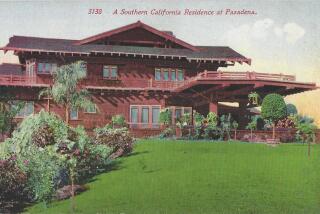Beauty, Charm of a Victorian Home : Architecture: The sweeping and varied designs cover a major part of the 19th Century.
- Share via
Not much can match the beauty of a properly restored Victorian home.
Whether you’re lucky enough to own one or merely dream of someday buying a Victorian, there’s lots to learn about these romantic old houses.
Mention the word Victorian and many folks think of Queen Anne or Italian-styled structures. Although these are two of the more plentiful Victorian designs, many different styles fall into this sweeping period--a time span that covers the better part of the 19th Century.
The earliest Victorian style, the Gothic Revival (1835-1865), was based on the romance of medieval architecture and inspired by English and German cottages. You’ll recognize a Gothic Revival house by its sharply pointed gables. Windows are usually tall and thin, sometimes with diamond-shaped, leaded panes. Medieval motifs, such as Gothic crosses and trefoils, may be cut into the structure’s woodwork.
The Gothic revival gave way to the Italianate period (1845-1880). Based on the cottages of Italy, houses of this style are characterized by their arched windows and doors, sometimes topped with decorative lintels. The Italianate mansions commonly have flat, wide roofs with large brackets under the overhang. A cupola often crowns the top. These highly symmetrical houses were often built from natural local stone or brick.
Few smaller houses were constructed in the Second Empire or Mansard style (1860-1885). Usually considered mansions, they are easily recognized by their distinctive mansard roofs, often tiled in slate, and dormer windows. Carpenter Gothic (1870-1910) houses feature lots of sawn-wood ornamentation, called gingerbread, at gable peaks and verge boards. Porches have sawn brackets on posts and cornices.
A rule of thumb when approaching this or any type of restoration is to try to save as much of the original structure as possible. In a Victorian restoration, particular emphasis is placed on preserving the ornate architectural details, along with the original siding materials.
If you’re lucky, the original gingerbread or brackets may only need repainting. If not, you’ll find they are rotted or damaged beyond repair. If that’s the case, you can either have replacements custom-made or order new reproductions from the millwork companies that specialize in this type of thing. The latter is the most economical if several pieces are missing or damaged. When you need to replace only a few, the custom route makes sense.
As far as siding goes, it can be fairly easy to restore the wood. In most cases, it involves paint removal, sanding, priming and repainting. Damaged pieces are either patched and repaired or replaced. Don’t be tempted to replace wood siding with vinyl or aluminum. You’ll lose the texture and a lot of the authenticity of your Victorian house.
When it comes to roofing materials, most houses built in the 19th Century had wood-shingled roofs, usually made of cedar. Slate and tile roofs were also common. In most cases, today’s asphalt shingles, which come in a variety of textures and colors, are an acceptable and less expensive replacement.
Occasionally, some owners find it necessary to add some living space to their old house. As long as the front and sides of the structure are maintained historically, the back end can usually be altered without losing the charm.
Distributed by AP Newsfeatures.

